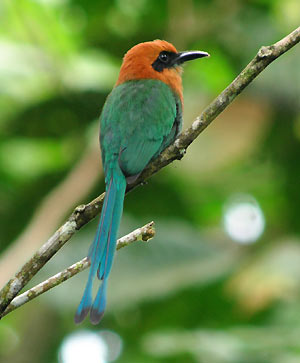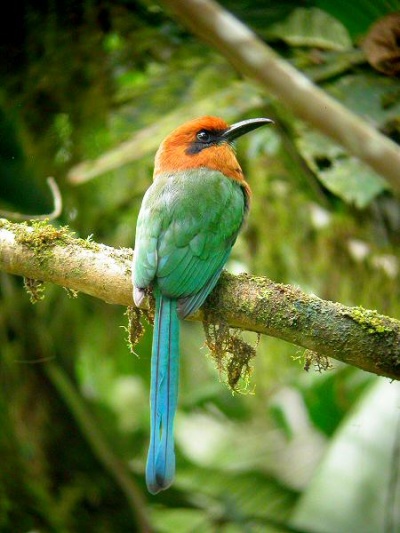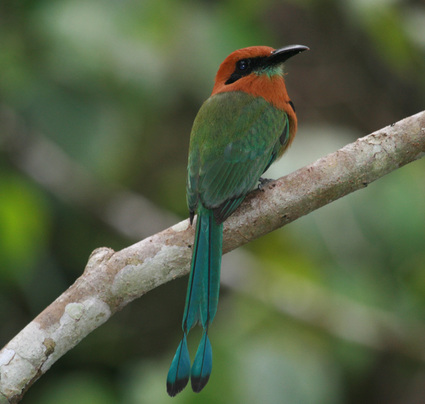
Electron platyrhynchum
TAXONOMY
Momotus platyrhynchus Leadbeater, 1829, Brazil. Six subspecies.
OTHER COMMON NAMES
English: Plain-tailed motmot; French: Motmot а bec large;
German: Plattschnabelmotmot; Spanish: Momoto Picoancho.
PHYSICAL CHARACTERISTICS
2–2.3 oz (56–66 g); 12–15 in (31–39 cm), with an unusual
widened bill form. Head, neck, and chest are rufous with a
black mask on face. Blue-green underbill and black spot on
chest. Green upperparts, blue-green belly, and green bluish
flight feathers.
DISTRIBUTION
Honduras to northern Bolivia and Mato Grosso, and eastward
to Paraguay; overlaps geographic
DISTRIBUTION
of several other
motmots.
HABITAT
Tropical evergreen rainforest and secondary vegetation; may
range to 3,600 ft (1,100 m).
BEHAVIOR
Appear solitary but seem to maintain pair bonds during and
between years. They are not very active and often go undetected.
Tail often pendulates, sometimes jerkily. Inactive at
night, but active during twilight at dawn and dusk. Calling
most active at early morning light.
FEEDING ECOLOGY AND DIET
Consumes mostly insect adults and larvae, including butterflies,
dragonflies, and Panaponera ants as well as spiders, centipedes,
scorpions, small lizards, and frogs. Takes fruit minimally. Takes
prey on the wing during sallying, or gleans off the ground. Follows
trains of army ants to consume displaced insects.
REPRODUCTIVE BIOLOGY
Nest holes are 3.2–6.6 ft (1–2 m) long and may change direction
suddenly. Conspicuous opening is in vertical earth banks,
on river banks, on steep slopes beside roads or railways, or in
cave or well fissures. Partners relieve each other during incubation
twice in each 24-hour period. Young broad-billed motmots
hatch naked and blind; they rest on rumps and “ankles,”
which are protected against friction by calluses. Both parents
feed young, initially with squashed arthropods and soon with
adult-sized pieces of food.
CONSERVATION STATUS
Not threatened.
SIGNIFICANCE TO HUMANS
None known.
Other popular Animals
Photo Gallery of - Broad-billed motmot




 Animalia Life
Animalia Life